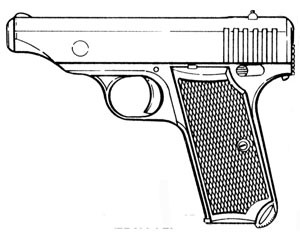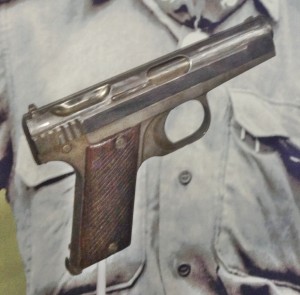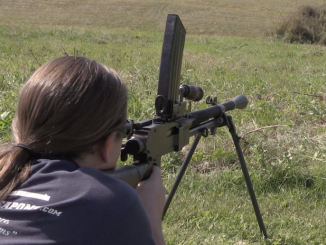A couple weeks ago, the folk at Weaponsman sent us a photo of an odd pistol on display – unlabeled – at the Special Forces Museum at Fort Bragg. They were wondering if we know what it was, and we took a guess at “Chinese handmade knockoff”. Well, to our embarrassment we were wrong; it was a Japanese Hamada Type 2. Having realized that, it seemed like a good idea to provide some more information on the Hamada.
The story of the Hamada pistol starts in 1895, when the Hamada Gun Shop was opened on Tokyo, and soon became well known for excellent quality hunting rifles and shotguns manufactured on site. The shop owner’s son Bunji Hamada was born in 1901, and became active in the shop at a young age, proving to be a very talented gunsmith in his own right. The shop continued to make high-end sporting arms until 1941, when the supply of material became too heavily restricted by wartime demands. At that point, the shop turned to military production. The standard Japanese Type 14 Nambu pistol was expensive to manufacture, and importation of American and European small pistols (traditionally favored by Japanese officers) had dried up because of the war. A cheaper substitute pistol was needed, and Hamada produced a design which beat several competitors to win an Imperial Army contract.

Hamada’s pistol, designated simply “Hamada Type” was heavily based on the Browning 1910 automatic pistol. It offered an increased magazine capacity of 9 rounds, and was chambered for the .32 ACP cartridge (many other .32 ACP pistols were in use with Japanese forces). It was produced from 1941 until February 1944 in Hamada’s Tokyo shop, with a total of 4500-5000 being made. All of these were sent to China, which explains their scarcity in the west today. Only 27 are documented to exist over here, and they are all between serial numbers 2214 and 2959. Very likely a small group of Japanese soldiers who were issues Hamada pistols were transferred from China to the Pacific islands, and a few of their pistols captured by US soldiers and brought home. All the other .32 caliber Hamadas were either destroyed or remain in China.
These first group of Hamada pistols showed excellent standards of quality in their manufacture and finish, as one would expect from a company with a reputation built on high-end sporting guns. A number of details about the gun were changed throughout the production run, including the number of slide serrations, grip panel design, serial number marking style, and a few others.
Hamada Type 2
Named for its initial design in 2602 (1942 in the Gregorian calendar), the Type 2 Hamada was an adaptation of the original gun to 8mm Nambu. The military was slower to adopt this 8mm version, apparently because of tension between military ordnance officers and the notably non-military lineage of Hamada and his pistol. Several variations were made to the gun through a back-and-forth series of trials, and by incorporating several preferences of the Major running the Army Technical Research Institute responsible for adopting the gun, Hamada finally got it accepted. The gun was basically a scaled up version of the original, with the final version featuring a longer barrel, steeper grip angle, and magazine capacity reduced to 6 rounds. The pistol was formally adopted by the Japanese Army in June of 1943.
A particularly distinctive feature of the Type 2 Hamada is the pair of semicircular cutouts made to the rear top of the slide, to reduce its weight. These are clear on the Type 2 that Weaponsman photographed at Fort Bragg:

Interestingly, this particular example is one of the very last prototypes made prior to serial production. It is marked “1” on several parts, and remains unfinished in the white.
The Hamada had been originally purchased as a way to reduce costs in pistol procurement, but as with so many military projects worldwide, the cost had inflated by the time they were ready for production. Ultimately the cost for a Type 2 was found to be 164 yen 98 sen each, (compare this to the Type 94 Nambu, which was allocated 80 yen per unit). A textile factory in Notobe was modified for pistol production with the assistance of the Nagoya arsenal, and the Type 2 was manufactured there from February 1944 until the end of the war.
In exchange for the assistance setting up the factory, the Hamada pistols were to go through bluing and final inspection at Nagoya’s Toriimatsu factory. The first batch of 500 guns were delivered to Toriimatsu in 1944, and another thousand by the end of the war. However, Toriimatsu only recorded delivery and processing of the first batch of 500. The first 50 of those were set aside for some reason, and guns form this batch make up all of the 17 known Type 2 Hamadas known to still exist in the US. The remaining 450 were probably sent as a group to a single unit in China, and either lost there or sunk en route by US submarines. The remaining thousand or so guns built but never blued have never been accounted for. Most likely, they were destroyed at the end of the war as scrap, although it is possible they were simply issued in the white as demand for guns became more desperate.
Hamada Himself
Bunji Hamada survived the war, having moved from Tokyo to the factory at Nobuto in 1944. When the war ended, he opened the Hamada Gun and Powder Shop in Kamakura City, where he returned to his passion for building hunting rifles. Japan’s gun laws kept it as a small shop, but Hamada continued to run it until his retirement in 1977. He was interviewed by Harry Derby and James Brown (authors of the standout encyclopedia of Japanese handguns, Japanese Military Cartridge Handguns 1893-1945, from which this information is taken) in 1981, at which time he was still actively competing on the shotgun range using a 12ga over-under he had manufactured in 1927 (the first model of over-under shotgun made in Japan) We don’t have any information on Hamada-san’s death, but he would be 111 years old today if he still survives.



Great research, Ian. I’m going to direct the museum folks over here, specifically SFC Rodney Cox. The part of the museum where the Hamada is displayed displays artifacts from OSS Detachment 101 and other OSS operations in the China-Burma-India theater.
Since SFC Cox ID’d the Hamada (actually, passed on the ID from another SF retiree), we’ve looked at some online resources. And I’m curious where your Hamada numbers come from, but guessing Derby and Brown. The reason is, several Hamadas seem to have surfaced every couple of years. There was a Type I on GunBroker a while ago (it sold for between $4 and $5k), and there’s an online weapons forum where the members discuss someone walking in with a Type II in a Type 94 holster. The question is, of course, are these new Hamadas or were they already counted on Derby and Brown’s census?
At B-School, one of the number tricks they teach is called the “Tiger Tank Problem” and it dates from a WWII intelligence analyst’s use of a frequentists statistical method to make an accurate (uncannily accurate, actually) estimate of tank production (he was actually counting Panthers, but MBAs are all about precision, not accuracy). There’s a somewhat chaotic explanation of the method on wikipedia:
http://en.wikipedia.org/wiki/German_tank_problem
There are much better explanations online in b-school class notes and in b-school stats textbooks. There is no reason you couldn’t modify this method in stages to calculate (1) total production and then (2) statistically likely survivorship.
More sophisticated versions of this kind of statistical analysis are still part of analytical tradecraft.
Japanese handgun production was much lower than that of any other wartime power, and less than that of much smaller nations like Czechoslovakia, Poland and Hungary. It’s possible that even Norway outproduced Japan; I certainly see more Norwegian Model 1914s than Japanese pistols (but this could be survivorship effects).
And you’re quite correct in pointing out the effect of US submarine warfare in the Pacific. (If our subs had had working torpedoes earlier it could have made a bigger impact yet, but BuWeps wouldn’t admit their torps stank… the Japanese torps were awesome weapons by comparison, but they didn’t have enough subs, and our supply lines weren’t 100% maritime).
Lightening cuts on the slide – Ouch!
I’m guessing they were to allow the gun to operate with a stronger recoil spring than it was originally designed with.
and I’d almost put money on it, that such a spring was needed to fully chamber over sized cases that had been formed in worn out dies
If I’m correct, it says much of Hamada.
A bubba would have used a sloppy over sized chamber.
I saw my first 32 acp Hamada at a Kansas City show in about 1969. Our first thoughts were it might be Chinese but decided it must be Japanese. The gun was purchased from a vet who said he had entered a bunker that had stacks of wooden cases. He said he knocked over a stack several of the crates broke and out spilled a batch of these pistols. He picked one up and kept it as a souvenir. He said that after leaving he tossed in a satchel charge that triggered secondary blasts that crumpled the bunker. He wished he had taken more if he had known someone would pay $300.00 for one.